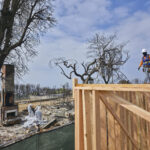On the count of three, a scrum of Washington sixth graders flung themselves in the air, landing with a thud that vibrated the ground under their feet.
Nearby, their classmates huddled around a computer, watching jagged tracings scroll across the screen as sensors picked up shaking from the mini-earthquake at Lackamas Elementary School last week.
Surrounded by boisterous 11- and 12-year-olds, geologist Recep Cakir explained that he and his crew are measuring the way seismic waves move through the soil to estimate how hard the ground will shake in future earthquakes.
The work is part of a pilot project, which also includes building inspections, to determine how well several Thurston County schools will stand up to a major quake.
With a $45,000 grant from the Federal Emergency Management Agency (FEMA) and volunteer assistance from structural engineers, the project is evaluating the seismic safety of 15 schools in three districts.
But the bigger goal is to develop a standard process that could be applied to schools across the state, said John Schelling, of Washington’s Emergency Management Division.
“The time is right to look at the state of the science and really assess how vulnerable one of our most precious assets is – our kids,” he said.
Over the past 25 years, scientists have discovered that the Pacific Northwest is subject to megaquakes and tsunamis from the offshore fault called the Cascadia Subduction Zone, as well as powerful, shallow quakes on faults under Seattle, Everett, Tacoma and other cities.
But many of the state’s schools predate modern building codes that take those hazards into account.
Using a FEMA model and an estimate of the mix of building types across the state, the Office of the Superintendent of Public Instruction (OSPI) calculated a magnitude 9 Cascadia quake could hypothetically cause more than $4 billion in damages and loss of services at school facilities, kill 117 students and staff and injure more than 3,000.
A similar analysis by FEMA estimates half the schools in Washington’s I-5 corridor would suffer medium to high damage.
But no one really knows how widespread the risk is – or which schools are in the greatest peril.
“Washington is really the only state on the West Coast that hasn’t completed a detailed, comprehensive assessment of all school facilities,” Schelling said.
California first started evaluating and upgrading schools in the 1930s. British Columbia made seismic safety a priority a decade ago and has spent $2.2 billion to strengthen high-risk schools.
Earlier this year, Oregon’s state Legislature earmarked $300 million to retrofit schools and other critical facilities, spurred by a survey that found 1,100 school buildings potentially at a high or very high risk of collapse in a major quake.
“I think it’s pretty safe to say it’s a similar story in Washington,” said Cale Ash of Degenkolb Engineers, who’s helping coordinate the pilot project and donating time to inspect school buildings. “The two states have similar ages of construction.”
In Washington, the seismic safety of schools is primarily the province of school districts. Thanks to voter-approved levies, Seattle has retrofitted the majority of its older school buildings and several projects are in the works. But in less-affluent districts like Aberdeen, where a previous survey identified seven schools and administrative facilities at high risk of collapse, there’s little money to pay for upgrades.
Many districts haven’t evaluated the seismic safety of their schools. The state Legislature also failed to act on recommendations from the Washington State Seismic Safety Committee to fund a statewide survey.
OSPI recently analyzed earthquake, flood and other natural hazards confronting schools across the state. Among its findings is that 32 schools and school facilities sit in the likely path of a Cascadia tsunami. But only 25 of the state’s 295 school districts have signed on for more-detailed analysis of the threats they face.
“It’s important to get a baseline assessment of where we are statewide, so we can understand how pervasive the problems are and give districts good information so they can set priorities,” Schelling said.
During the pilot project in Thurston County, engineers are inspecting each school, looking for structural weaknesses and hazards like bookshelves that aren’t bolted to the wall. Those observations will be combined with the data Cakir and his team are gathering on how solid – or shaky – the ground is at each site.
It’s important to examine each building, Ash said, because looks can be deceiving.
For example, Lackamas Elementary’s Craftsman-style main building and gym were constructed in the early 1900s and at first glance seem like they would be reduced to rubble if the ground shook very hard.
But both buildings got retrofits in 2005, including new shear walls and bolts to secure the frames to the foundations. Throughout the buildings, shelves and coat racks were also firmly attached to the walls.
The only concern turned up during the inspection was an unsecured heating system that might be damaged in a quake, Ash said.
A report on the pilot project, which covers schools in the Yelm, North Thurston and Tumwater school districts, is expected in February.
Expanding the survey program across the state would cost about $13 million and take about eight years, said Tim Walsh, chief hazards geologist for the Washington Department of Natural Resources. The agency also employs Cakir and his team, and is overseeing their seismic surveys.
Beyond the immediate priority of keeping kids safe, school upgrades can also ensure that buildings are usable as emergency shelters after a quake – and that kids can get back to school quickly, Ash pointed out.
“The key to resilience is getting the economy up and running again,” he said. “If you’re a parent, and school isn’t in session, that can hamper the recovery process.”
Was this article valuable?
Here are more articles you may enjoy.

 Flyers Avoiding Newark Airport Over Safety Fears
Flyers Avoiding Newark Airport Over Safety Fears  Spain Blackout Shows Need for Batteries in Renewable-Heavy World
Spain Blackout Shows Need for Batteries in Renewable-Heavy World  In The Wake of Devastating LA Fires, Residents Begin to Rebuild
In The Wake of Devastating LA Fires, Residents Begin to Rebuild  Shedeur Sanders Fan Sues NFL for $100M Over Quarterback’s Draft Slide
Shedeur Sanders Fan Sues NFL for $100M Over Quarterback’s Draft Slide 